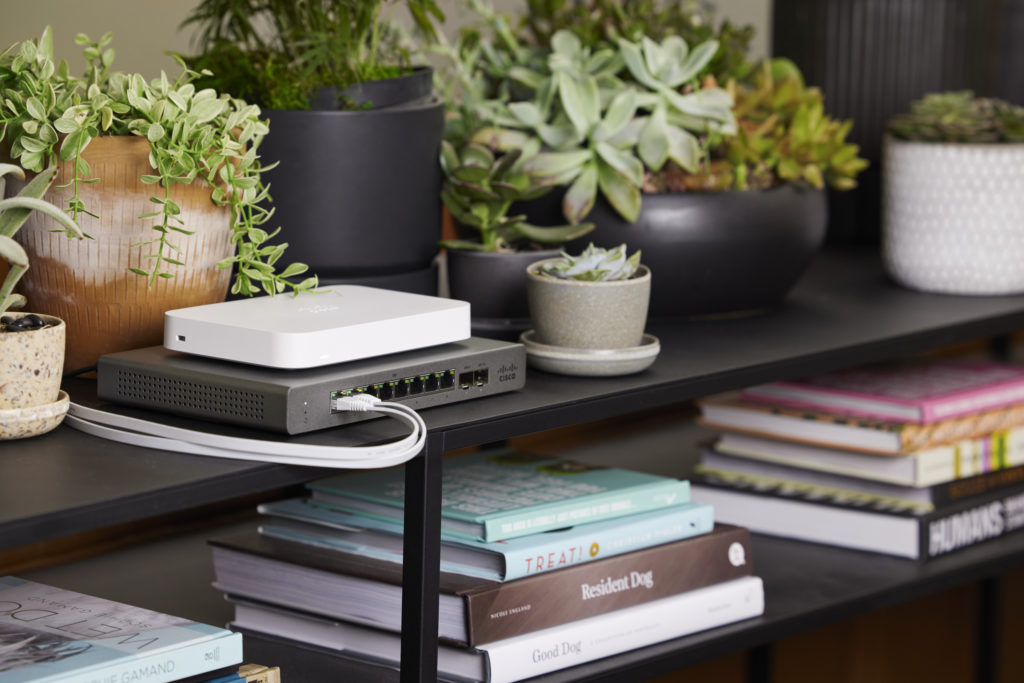Remember the days when our homes had one desktop computer? We connected it to the internet with an ethernet cable. And everyone in the house shared that one computer.
Our world is completely different today. We now have a vast number of connected devices in our homes. We also use WiFi in a variety of ways. Our work, education, and entertainment are all done online and frequently require WiFi. All of this activity can be extremely demanding on a wireless network. We always say to small businesses, “The wireless router you get from your internet service provider is simply not enough.” This may now be true for you at home as well.
As a result, we decided to delve into the two big reasons you should now consider bringing business-grade WiFi into your home.

Support for multiple devices
Business-grade WiFi is designed to handle a high density of devices without sacrificing performance. This is especially true of WiFi 6 access points, which were largely designed for increased capacity. Though business-grade WiFi is invaluable in brick-and-mortar stores such as restaurants and retail, it can also make a huge difference at home where multiple devices are connected at once.
According to Deloitte’s most recent Connectivity & Mobile Trends survey, 66% of U.S. households now have smart devices. Further, there is an average of 22 connected devices in each household. An average of 22! Everything seems to be smart in today’s homes:
U.S. households now have an average of 22 connected devices
SOURCE: Deloitte 2022 Connectivity & Mobile Trends survey
- Laptops, tablets, and phones
- Video streaming devices and smart TVs
- Gaming gear
- Wireless headphones and speakers
- Kitchen appliances–refrigerators, stoves, microwave ovens, coffee makers, dishwashers, toasters, and more
- Washers and dryers
- Thermostats and air quality sensors
- Security (e.g. Ring and webcams)
- Smart assistants (e.g. Amazon Echo and Google Home)
- Wearables (e.g. Apple Watch and Fitbit)

Support for multiple needs
In addition to the sheer number of connected devices, never before has there been such a blurring of lines between home and business. Accelerated by the pandemic, many of the rooms in our houses have now become offices, schools, and small businesses.
Need #1 – Working
It’s now a fact – home WiFi must be able to support hybrid work. According to recent research from Stanford economist Nick Bloom and extensive work from Bianco Research, hybrid work is here to stay. Many companies have found success with employees working 3 days in the office and 2 days at home. And still more companies (like Cisco) are empowering employees with 100% remote work. This is one of the reasons reliable WiFi is critical and why Virtual Private Networks (VPNs) have surged in popularity.
In addition, the U.S. Small Business Administration reports that 50% of all businesses start at home. Further, 60% of all businesses without staff continue to be home-based. Note that this accounts for the majority of small businesses; of our country’s 37.1 million small businesses, a whopping 25.7 million have no employees at all – only the owner.
50% of all businesses start at home and 60% of all businesses without staff continue to be home-based
SOURCE: U.S. Small Business Administration
Retail start-ups will also opt to open an e-commerce store rather than investing in rent for a physical location. This of course requires an internet connection and, most often, a reliable wireless network as well. There are many things that entrepreneurs can do from their home offices, but they need business-grade WiFi to do it.
Video conferencing is one aspect of both hybrid work and running a small business today. Just receiving a 1080p HD video stream consumes 1.8 Mbps of data, which translates to 810 MB per hour. That doesn’t even include the video stream you’re uploading.
Yet another component of our professional and personal lives today is the need for online storage. Like video conferencing, Dropbox and other storage applications can gobble up a lot of bandwidth if uploading and downloading files via WiFi.
Video communications and computer storage are just two examples of applications that have evolved over the years and become essential to businesses as well as individuals. Working at home now needs the same degree of security and connectivity that exists in any business location.

Need #2 – Education
It’s understood that the pandemic changed many things in our lives, and a big one is education. E-learning had already been growing in popularity through the early 2000s, but the pandemic really proved just how much could be done online. Instructors taught all types of classes and to students of all ages.
Though everyone has largely returned to in-person classes today, there is still a considerable amount of e-learning and education done online. Helen Vlasova, co-founder of career guidance website Admissionsly.com, shares:
- 45% of elementary school students use digital tools daily for online classes
- 63% of high school students use e-learning tools every day
- Over 3 million students complete their higher education online
In addition, online education is beneficial for professionals who want to continue working while taking personal development classes or completing an additional degree.
Need #3 – Entertainment
In addition to working and education, our entertainment today demands an awful lot from our WiFi.
Video streaming is one of our most popular forms of entertainment. Today it is so completely integrated with our lives that we don’t even think about it. We watch it through our smart TVs, Rokus, laptops, and phones. YouTube has 246 million viewers in the U.S. with 70% of its watch time coming from mobile devices. Netflix, the most popular streaming service, has over 236 million subscribers. That kind of viewership is demanding on your WiFi. Streaming Netflix in HD uses up to 3 GB per hour. Netflix in 4K uses even more.

That said, video streaming has nothing on gaming when it comes to the need for bandwidth. Gaming is another extremely popular form of entertainment. According to Statista, there were nearly 189 million gamers in the U.S. in 2022. Of those, 150 million were accessing the games through mobile devices. In article after article, gamers mention the need for stable WiFi with low latency. They also recommend upgrading your wireless router and investing in WiFi 6 access points.
Consider that online multi-player games–such as Fortnite or Minecraft–use approximately 100-150 MB of data per hour, which is comparable to video streaming. But if you want to experience streaming and cloud gaming in 4K, you need approximately 126 GB of data per hour. Even simply using a wireless gaming console eats up a lot of bandwidth.
In contrast, music streaming seems like it’s barely taxing your bandwidth. Yet we all experience the dreaded buffering. Applications like Pandora, Spotify, and Apple Music use approximately 144 MB of data per hour. However, it does add up. If you listen to one of those applications through an entire 8 hour day, you’re looking at 1 GB of bandwidth.
Benefits of business-grade WiFi
Because today’s home uses technology in sophisticated ways, business-grade WiFi is quickly becoming an essential. Consider that its benefits include:
- Reliable connection
- Greater coverage area
- Enhanced security for your business and personal data
- Ability to create multiple networks for different needs
- Ability to easily expand your network, including outdoors
- Insights into network usage and potential threats
Business-grade WiFi’s ability to segment your network is particularly useful in your home. For instance, Meraki Go’s Router Firewall and Router Firewall Plus (with VPN) allow you to create separate networks for your family’s needs. This might mean one network for your business activity, another for online education, and another for entertainment and/or guests. Segmenting your network ensures that your child’s education or entertainment activity, for example, will not impact you while you’re working online at the same time.
Meraki Go’s WiFi 6 access points also give you increased speed and capacity that allows up to 100 connected devices. And the Meraki Go app provides insights into your network health and activity, which can help you prevent anything (or anyone) from gobbling up your bandwidth.
Because we pride ourselves in being a partner of small businesses, we can also support you at home. Meraki Go is affordable while also being reliable, secure, and easy to use. It is invaluable for anyone who relies on a robust and efficient network for their activities whether you’re at your business or at your home.

SOURCES:
Bianco Research
Cisco Meraki
Nick Bloom
Deloitte Connectivity & Mobile Trends survey 2022
How To Geek
Inc. magazine
Lifewire
Netflix
Statista
U. S. Census Bureau
U. S. Small Business Administration
Helen Vlasova, co-founder of career guidance website Admissionsly.com
YouTube





